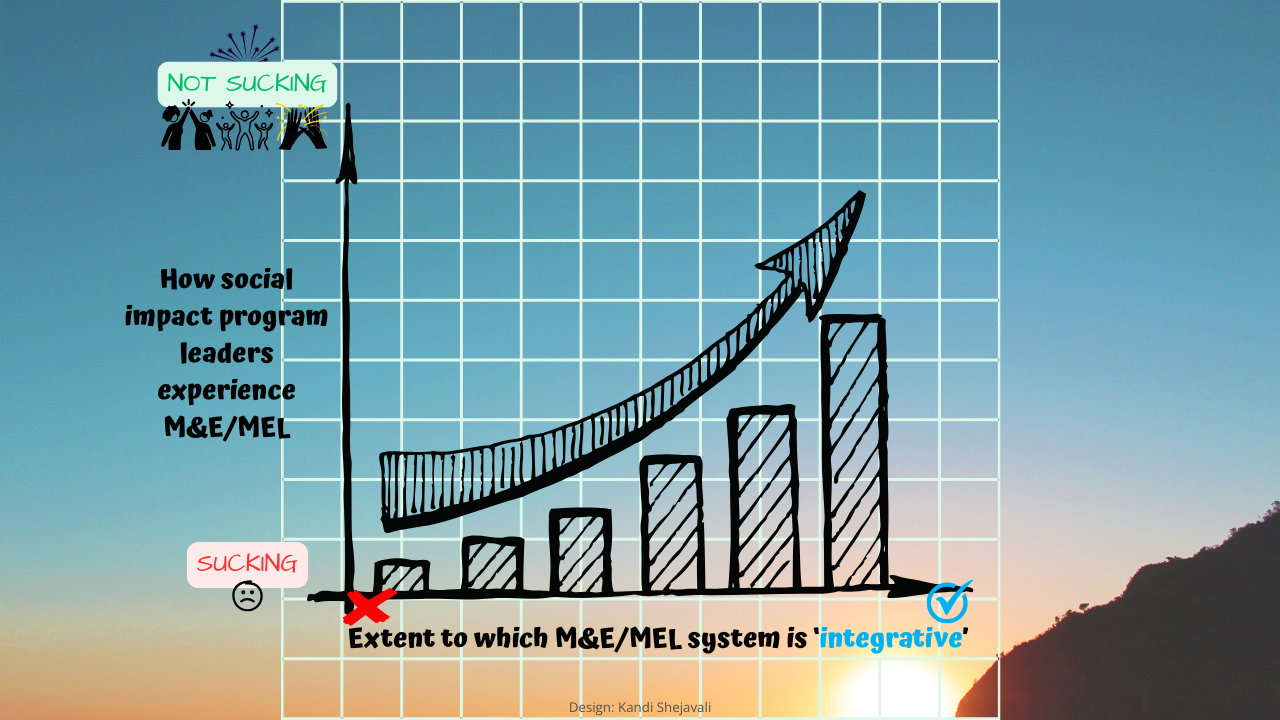First things first: put the conventional M&E tools down and back away slowly
May 09, 2022
Newly assigned to conduct M&E for a social impact program (e.g., international development project, nonprofit program, CSR program, etc.). Rush in with M&E guns blazing, right? Umm, not so much.
When a monitoring and evaluation (M&E) practitioner is presented with a program that he or she has never monitored before, what’s the first thing he or she should do? I was glad to receive this question from an M&E specialist as responding to it provides the opportunity to touch on some of the softer skills required in M&E.
So, what is the response to the question?
Rush to the M&E toolbox to pull out indicators and indicator documentation templates, theories of change, report templates, data collection instruments, dashboards, and other elements typically associated with M&E?
Certainly not!
In fact, the conventional M&E toolbox should be put aside altogether in favor of something entirely different: curiosity.
[RELATED RESOURCE: In case you’re not only new to a program but also new to M&E, download my short introductory guide to M&E fundamentals, Basics of M&E: A cheat sheet for beginners.]
Curiosity may have killed the cat, but it brings M&E to life
Defining curiosity
The following definition of curiosity offered by the Merriam-Webster dictionary is particularly appropriate for the term’s application to M&E:
- “desire to know…interest leading to inquiry” (Merriam-Webster 2022)
This definition perfectly reflects what an M&E practitioner should incarnate when taking on a new project – and throughout their career, by the way – not to mention that the definition also echoes what M&E as a whole is all about.
Curiosity is king because, more than any technical M&E tool or data collection methodology, the depth of an M&E practitioner’s understanding of the program largely determines the extent to which the M&E system he or she sets up and/or manages for the program will be effective and practical, i.e., fit-for-purpose. Or, put differently, the deeper the M&E practitioner’s understanding of the program and its context, the more likely it is that he or she will conduct awesome M&E!
And the necessary depth of understanding can only be gained through a sincere desire to know and via the effective conduct of related inquiry (which implies great listening, another essential skill for M&E).
But desire to know what exactly?
So, what exactly should the M&E practitioner desire to know? Well, just about everything that has to do with the program, especially if the practitioner’s role is to manage the overall implementation of the M&E system.
And I really do mean just about everything.
Here are some examples of the just about everything:
- the program’s geographic coverage and key features of that geography;
- the culture(s), population size, and other characteristics of the population affected by the program;
- the program’s explicit, or “official”, and implicit objectives;
- the program’s objectives according to each team member (trust me, they will be different from each other, and there will be variation from the “official” objective!) as well as the specific purpose of any sub-activities that each team member is responsible for, and what ‘success’ would look like from their perspective;
- the affected population’s understanding of the program’s objectives, and what ‘success’ looks like in their eyes;
- key partners’ and other stakeholders’ understanding of the program’s objectives, and what ‘success’ looks like to them;
- key details related to the sector in which the program operates (no need to become a sector expert, but a basic understanding of the domain is important, including how it functions overall, key actors, measures used to assess progress in the area, recent publications providing a picture of the current lay of the land);
- the program’s actual or anticipated start and end dates, including intermittent phases;
- the stage the program is currently in;
- the program’s budget;
- the program’s staffing structure and the responsibilities of each team member;
- the program’s implementation modalities;
- the forms and templates used in the course of the program’s operations, along with the purpose of each, by whom they are used, when are they used, to whom are they submitted, and what the person to whom they are submitted does with the information contained therein;
- the structure and elements of the program’s existing M&E system, if any;
- program team members’, donors’, affected population members’, and partners’ thoughts about the effectiveness and practicality of the existing M&E system, if any, and their M&E needs;
- findings from any evaluations of the program conducted to date.
(I think I’ll end there. You get the picture, plus I’m running out of bullet points.)
Consider a variety of ways to conduct the inquiry
A couple of tips for M&E practitioners conducting an inquiry about a newly assigned program in order to gather the information listed above:
Consider a variety of ways to obtain answers, and start with a document review. You don’t want to badger people with basic (or less basic) questions that can be answered through a review of program documents or a quick online search. Make the best use of your discussions by going into them with some background knowledge – but keep an open mind to ask for and/or hear fresh perspectives on what might seem obvious.
Keep your ears open all the time. The exact answers to what you seek to know may come in the context of a casual conversation. Remain alert for these gems. (This serves as a beautiful opportunity to give the gift of listening from a place of presence.)
If you must employ the term “M&E”, explain what you mean because not everyone will have the same understanding of what it is. For example, for many people, the equation is ‘M&E = indicators + reporting’, and that’s about it… whereas M&E is so much more.
Conclusion
A healthy dose of curiosity on the part of an M&E practitioner, and the conduct of an effective inquiry to satisfy that interest, makes for a more practical and effective – in other words, an awesome – M&E system.
That’s because the depth of the M&E practitioner’s understanding translates to things like:
- appropriately taking cultural, climatic, and other considerations into account when it comes to data collection;
- seamlessly integrating M&E requirements into existing operational templates and tools; and
- the provision of practical and actionable recommendations for program adaptation and other improvements.
Hello, burden-free M&E! (And the above are just a few of the multitude of examples. I would cite more, but now I’m really out of bullet points!)
Over to you!
PRACTICAL TIP #1: If you’re an M&E practitioner: whether you’re newly working on a program or you’ve been conducting M&E on the same program for a while, ascertain the depth of understanding that you have of the program and consider how that understanding has translated into the M&E system. Are there areas in which you could brush up your understanding and render the M&E system more fit-for-purpose?
PRACTICAL TIP #2: This one is for the human resources team: beyond technical skills, ensure that the M&E practitioners you hire demonstrate a healthy dose of curiosity and excellent listening skills. These qualities will translate to an M&E system that is appropriate to the program and its context, and, as a happy consequence, will lead to better programs results. Two BIG wins!
Update of 12 May 2022: Please share your thoughts and experience by commenting or leaving an emoticon reaction at the bottom of this LinkedIn post.
References:
Merriam-Webster, “Curiosity.” Merriam-Webster.com Dictionary. Available at: https://www.merriam-webster.com/dictionary/curiosity (accessed 3 May 2022).
Photo credit:
Bing Han on Unsplash
Suggestion for how to cite this article (using APA 7 style):
Shejavali, K. (2022, May 9). First things first: put the conventional M&E tools down and back away slowly (or Curiosity may have killed the cat, but it gave life to M&E). Blog post. RM3 Consulting. Available at: https://rm3resources.com/blog/first-things-first (accessed: [insert the date that you last accessed this article at the link provided]).





